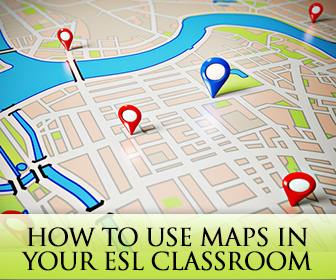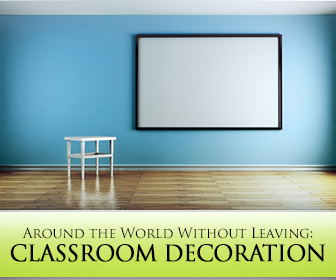Where Do We Go from Here? 6 Simple Ways to Use Maps in Your ESL Classroom


Good classroom decoration can be very motivating for ESL students, particularly when studying tourism. Being surrounded by common travel paraphernalia gives students some sense of a physical goal (they could be the ones drinking tea and speaking in London next year!) which puts them in the mood to study. These decorations can also serve as the basis for various activities throughout the year.
A well decorated English for tourism classroom ideally contains both realia (materials from the real world) and student produced work. Student projects not only provide the teacher decorating materials; they also allow students to have something physical to link to their language learning. Here are some examples of realia and related student activities to include in your classroom next year:

Posters are a cheap and easy way to give your classroom a bright punch of color. Examples of appropriate materials might include posters showing countries or cities, travel agent's fliers, or tour group advertisements. Not only can these posters inspire discussion, they can provide a useful template for students when making their own.
Student activities: One of my students' favorite classes is inevitably making posters. It's a fun break from doing worksheets, it fosters students' interpersonal relationships, and it allows them to get creative. Students should choose a country or city and prepare a poster highlighting its attractions. It is useful to give students some guiding questions to help them formulate their poster. Questions might include:
What objects come into your head when you think of ______?
What famous attractions are in your country / city?
How will you lay out your poster? (How much text? What pictures?...)
Students will soon forget that they are speaking English as they argue over what to include in their poster. For additional speaking practice, groups should prepare a short presentation about their final product.
Brochures function similarly to posters in the ESL classroom, but with the additional benefit of encouraging reading and writing skills. Brochures of all kinds (airlines, hotels, tours, etc) can be collected and displayed on the classroom walls or kept in a box for easy reference.
Student activities: You should start by introducing the concept of a brochure and giving a few examples using your realia objects. If you have time, it may be useful to use the realia as a basis for a short role play before students create their own. Role plays can include planning a day (provide 5-6 brochures to small groups of your students and tell them to plan their schedule for their day) or giving and getting directions (provide students with two brochures and a map and have them decide the best route to take). Doing these role plays are useful as students are able to look at the brochures closely and get an idea of what is usually included on them.
Once students are ready to create their own brochures it is often useful to start by brainstorming what topics could go on each page of the brochure. Allow each group to choose a country or city and, if you have enough time, have each group write the texts in their notebooks before creating the final product. A two step process allows for a neater, more coherent final product. Like with the poster activity, students should give a short presentation about their final product.
In the English for tourism classroom maps are one of the best decorations – not only are they visually interesting, but they provide an excellent basis for many speaking activities during the lesson. You can search for high quality maps online and print them out but it's far more interesting if you can hang real maps on the wall. Oversized, fold out maps are the best as they are easy for the students to see during the activities.
Student activities: One of the most daunting tasks for many tourism students is giving or getting directions in English. Maps provide an excellent resource to practice this task in the classroom. Before you begin any of these activities, be sure to pre-teach all the necessary phrases for giving directions. (Take a look at the map you'll be using before you begin to anticipate any particular language difficulties like roundabout or dead end!) Any number of role plays can be done using a map.
The first role play revolves around decision making. Divide students into pairs. They are visiting tourists and want to get to “Point A” to “Point B” – together they should decide the best way to get there. Feedback can include the whole class discussing alternate routes and defending their choices.
A second role play involves a little more mystery. Again divide students into pairs – this time with student A and student B. Give each a map with the same starting point. Student B's map should also have a finish point – their home. Tell students that A would like to visit B's home, but doesn't know the way. Student B should direct student A to their home without showing the map. At the end, they can compare maps and see if A arrived to the correct location. Students can switch roles and choose their own start / finish locations.
If you have your own personal classroom or understanding coworkers and a little bit of extra space, travel stations are an excellent idea for an English for tourism class. These stations are located around the room and represent different aspects of traveling abroad or working in the tourism industry. For example, your classroom might have an airport, a hotel, a museum, and a travel agency station. If you can anticipate which locations will be used most throughout your course, these are obviously the ones to choose as travel stations. These stations are not only visually interesting (each should be decorated with at least a sign or poster) but can help help students keep old lessons and vocabulary in mind (vocabulary and key phrases should be included in that area).
Student activities: First of all, it is important to make these areas. In some of your first lessons, you should assign groups to create each travel station you've decided upon. Be sure to be explicit in exactly what you want the students to produce – a specific location and related objects. For example, the travel agency station should have a poster with its name (“Liza and Marco's Travel Agency”) as well as some student-drawn pictures of what you might find there (computer, travel posters, etc). This process should last about one lesson – by the end you should have four travel stations to use in the future.
How exactly can you use these stations? After students have learned vocabulary or key phrases from this area, you should feel free to add the most important in large, clear writing to a poster in that area. The airport station might have vocabulary such as check in, security, and gate and target language like “I'm flying to New York today”, “Could I get an upgrade?”, and “Is my flight on time?”. Your classroom looks lively and whenever you revisit these topics students have an easy reference point.
While not a visual decoration, music can be a wonderful addition to the atmosphere of any classroom. Songs relating to travel are perfect for the English for tourism classroom: they can teach new vocabulary, revise grammar, and provide nice background music for various activities.
Student activities: Depending on the level of your class, you should choose an appropriate song somehow related to travel or a specific location. Good travel related songs include “Leaving on a Jet Plane” by John Denver, “Englishman in New York” by Sting, or “I've Been Everywhere” by Johnny Cash. Whichever song you choose, you should prepare a short worksheet to go along with it. A sample worksheet might include matching new vocabulary to the correct definitions, a copy of the song lyrics with some words omitted, and discussion questions for after listening. Don't be afraid to listen to the song three or four times in a class – the more students listen, the better they will understand. After completing the worksheet, play the song again and encourage students to sing. Some won't, but you would be surprised how many students are not afraid to belt out a song in English.
For a tricky bit of revision, replay the song during certain activities when students are working individually. Not only does playing music make the activity suddenly more interesting, you will see students lip-syncing as they work on their task! To mix things up a bit, teach more than one song and rotate between them.
Visual and auditory stimulation in the English for tourism class not only helps liven up the classroom, but in fact connects your classroom to the outside world. By involving students in producing and utilizing classroom decorations, your English for tourism lessons become more fun, more engaging, and ultimately more effective.
How do you utilize classroom decorations into your lesson plans?